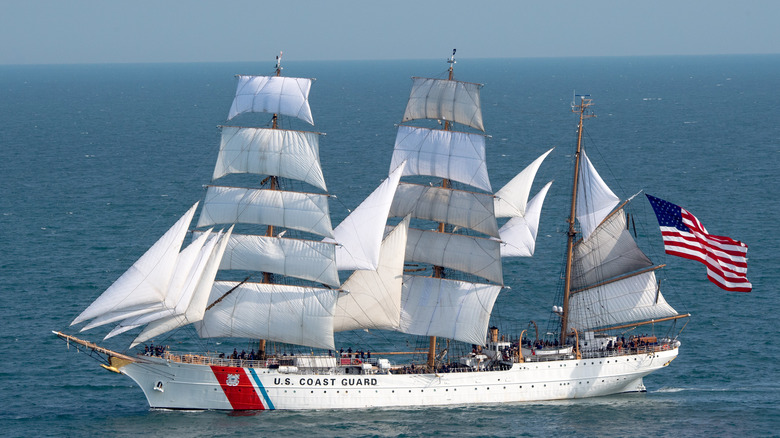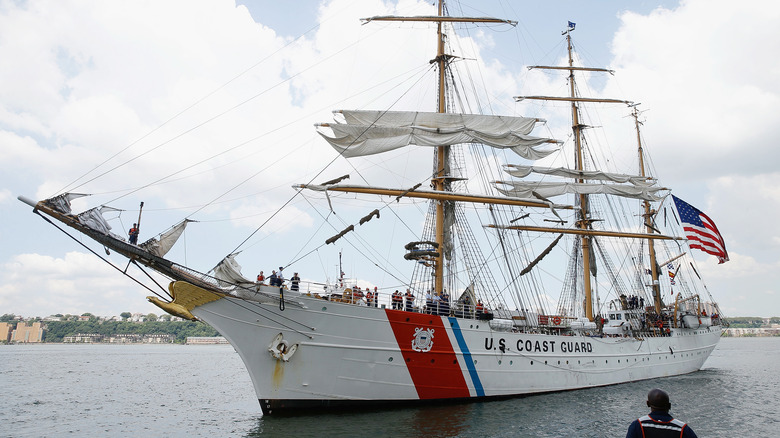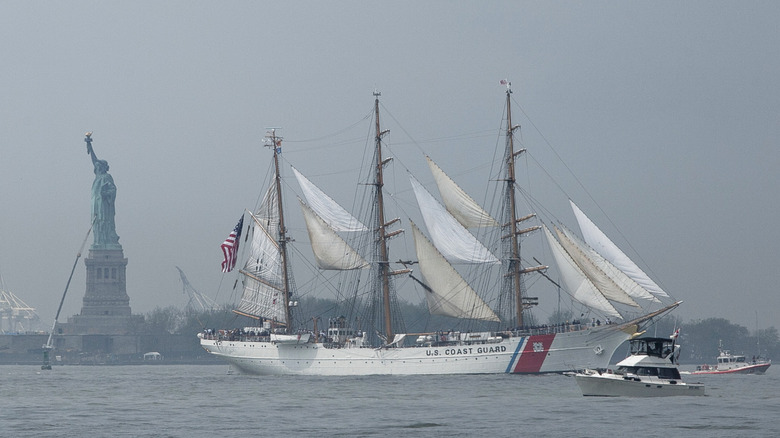The Amazing Story And Mission Of The US Coast Guard Ship Eagle
By 1946, years of war had destroyed large swaths of Germany's infrastructure, and the U.S. and other allied nations were picking through the ruins to see what might be repurposed or put to use. The German military had effectively been disbanded, including its navy, which was being haggled over as spoils of war. The U.S. Coast Guard needed a new training vessel and was lucky enough to find it in the destroyed German city of Bremerhaven. (Italy would end up giving battleship Littorio to the United States in the aftermath of WWII as well.)
Cmdr. Gordon McGowan, a teacher of seamanship at the U.S. Coast Guard Academy (USCGA) in New London, Connecticut, was sent to the bombed-out city to claim the ship from the derelict German navy in early 1946. The vessel wasn't the most legendary ship of World War II, and, upon seeing it for the first time, McGowan reportedly said, "Her gray sides were smeared with stains, the paint on her yards and masts blistered and cracked." Undeterred, McGowan enlisted the aid of the ship's former captain and crew to make her seaworthy and then sailed her back to the United States. McGowan rechristened the ship the United States Coast Guard Cutter Eagle (WIX 327) on May 15, 1946, and he and his mostly German crew set sail for the U.S. soon after.
The Eagle helped train the US Coast Guard
The Eagle's design and construction were indicative of centuries of shipbuilding skill. Running nearly the length of a football field, the ship has three masts and 23 sails that cover an area of 22,227 square feet. The vessel is outfitted with a steel hull and decks with 3-inch teak wood covering the forecastle, quarterdeck, and weather decks. On the open ocean and under full sail, the Eagle can achieve speeds up to 17 knots (20 mph) or, when powered by its 750 horsepower diesel engine, around 10 knots (11 mph). The ship is maintained year-round by a crew of eight officers and 50 enlisted personnel.
The arrival of the three-masted Eagle to the USCGA on July 12, 1946, was critical to the fulfillment of the academy's mission. Originally founded in 1876 as the U.S. Revenue Cutter School of Instruction — Underway, its first nine students undertook their curriculum aboard the schooner Dobbin. Today, the Eagle's mission is two-fold: train future officers on seamanship and serve a symbol of goodwill on public relations tours. Every crew, consisting of up to 150 cadets, learns critical skills such as navigation, engineering, and rigging. The time aboard the Eagle, according to the Coast Guard is an "experience [that] builds character and helps future officers develop skills of leadership and teamwork that prove valuable assets throughout their careers."
The Eagle provides cadets with invaluable hands-on experience
The Eagle has trained thousands of Coast Guard officers in its nearly 80 years of service. Classroom work and study is a critical component of every cadet at the USCGA, but the value of putting it all together and applying it in real-time in a hands-on environment such as what the Eagle provides has proven invaluable. The ship itself holds a special place in the pantheon of U.S. naval vessels, being one of only two tall ships in the military. (The USS Constitution, the world's oldest ship still afloat is the other.) Often referred to as America's Tall Ship, the Eagle stands alone as the only active duty sail-ship in military service.
The cutter Eagle remains an integral part of the Coast Guard's ability to train its future officers. The experience to sail aboard this classic vessel while learning and applying various skills from maneuvering, line handling, and identifying weather patterns, is a tactile experience that only the Eagle can provide. As a goodwill ambassador, the vessel also gives these cadets the opportunity to sail across the world. Every summer, the Eagle deploys to build and foster international relations in Europe, Africa, South America, or anywhere in between. The USCGC Eagle, a spoil of war, has established a legacy of maritime excellence while forging a path forward as an invaluable resource to both the USCGA and the United States.


